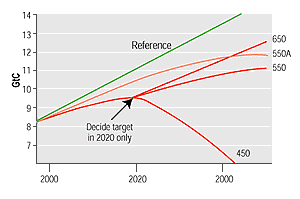|
10.1.4 Progress since the Second Assessment Report on Decision Analytical
Frameworks
Much work has been conducted since SAR. Work has focused on a wide array of
issues ranging from that which explores the tools of analysis to that which
employs those tools to shed light on the problem of climate change. Researchers
such as De Canio (1997), De Canio and Laitner (1997), De Canio et al. (2000a,
2000b, 2000c), Laitner and Hogan (2000), Laitner et al. (2000), Peters and Brassel
(2000), and Sanstad et al. (2000a, 2000b) have focused on integrated assessment,
endogenous technological change, and behavioural, social, and organizational
phenomena (discussed in Chapter 8). Work has also continued
to examine the problems of cost–benefit, cost-effectiveness, and the interaction
of uncertainty with decision making. New approaches have also been developed,
including, for example, tolerable windows and safe landing.
10.1.4.1 Decision-making under Uncertainty

Figure 10.1: Optimal carbon dioxide emissions strategy, using a cost-effectiveness
approach. |
Work has continued in the development of tools to understand
the influence of uncertainty on decision making. The initial work examined in
SAR explores the problem of emissions-mitigation objectives under a cost-effectiveness
framework, but the interaction between concentration limits and the date at
which uncertainty is resolved influences the results. This interaction occurs
because in decision analysis no option can ever be foreclosed before the date
at which uncertainty is hypothesized to be resolved. Any concentration ceiling
implies a cumulative emissions limit. Thus preserving the option to stay below
any arbitrary limit means adopting a hedging strategy. Grubb (1997) characterizes
the problem thus: “If we delay action in the belief that we are aiming
at a 500ppmv target, for example, then after a couple of decades it may be simply
too late to be able to stabilize at 400ppmv, however urgent the problem then
turns out to be; and even stabilization at 450ppmv might by then involve radical
changes of direction that could prove economically very disruptive.”
The core of the issue is the interplay between inertia and uncertainty; without
inertia any trajectory could indeed be corrected at no cost, but as inertia
is important, changing course may be very costly. Fortunately, the Convention
embodies the dynamic nature of the decision problem in drafting climate as an
ongoing process, not a “once and for all” event. The UNFCCC (1993)
requires periodic reviews “in light of the best scientific information
on climate change and its impacts, as well as relevant technical, social and
economic information.”
Such a sequential decision-making process aims to identify short-term strategies
in the face of long-term uncertainties. The next several decades will offer
many opportunities for learning and mid-course corrections. The relevant question
is not “what is the best course of action for the next 100 years”,
but rather “what is the best course for the near-term given the long-term
objective?”
There have been several attempts to frame the issue. Figure
10.1 reports the results of an analysis by Ha-Duong et al. (1997). The authors
use their model of the Dynamics of Inertia and Adaptability for integrated assessment
of climate-change Mitigation (DIAM) to determine the least-cost emission pathway
given an uncertain concentration target. A defining feature of their model is
an inertia parameter that accounts for the time scale of change in the global
energy system. In their analysis they assign equal probability to a target of
450, 550, and 650ppmv. The solid 550ppmv line corresponds to the optimal pathway
when the target is known to be 550ppmv from the outset. The analysis shows the
optimal hedging strategy when uncertainty is not resolved until 2020. The authors
note that “our results show that abatement over the next few years is economically
valuable if there is a significant probability of having to stay below ceilings
that would be otherwise reached within the characteristic time scales of the
systems producing greenhouse gases.”
The degree of near-term hedging in the above analysis is sensitive to the date
of resolution of uncertainty, the inertia in the energy system, and assumes
that the ultimate concentration target (once it has been agreed) must be met
at all costs. The last stems directly from the formulation of the problem as
one of finding the least-cost mitigation pathway in the face of uncertainty.
Since a future political decision on a 450ppmv target cannot be excluded, decisions
prior to 2020 must be such that they do not preclude the achievement of such
a target.
Continues on next page
|